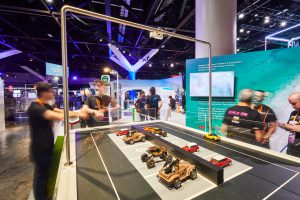A revolutionary cloud technology could take the pain out of parking by showing real-time images of vacant parking spaces on a smart phone and sending updates when a space is expiring.
The technology could be game-changing for councils, its developers say, by helping improve compliance with parking limits and even allowing councils to change time limits and reduce congestion by redirecting traffic.
New cloud software from Amazon Web Services is taking smart sensor parking to the next level, potentially allowing locals to see a virtual representation of empty or busy spaces in car parks and local streets in real-time before they even arrive at the spot.
The technology, unveiled at the Amazon Web Services Summit this month, could also be used to update users on the time limit of parking spots, potentially helping them avoid getting ticketed.
The cloud service, which integrates with parking sensor and camera technology, can be used at shopping centres or on busy local streets to allow users to virtually ‘see’ the availability of parks ahead of time, preventing people from driving around in search of vacant spaces.
Simon Elisha, Head of Solution Architecture, ANZ Public Sector, Amazon Web Services, told Government News that the IoT and data management services used to build this display are already being used by local city councils and partners across Australia and the globe.

Mr Elisha said that the technology could be game-changing for councils, and the “sky is the limit” when it comes to potential uses.
“You can imagine from a citizen’s perspective I could drive to local shopping centre, look at an app on my phone and see whether there’s spare parks or whether I should avoid that location because it’s full,” he said.
The technology links up sensors and cameras in car parks and streets, like the ones currently in use at shopping centres across Australia, with a software that shows a virtual representation on any device.

The technology can also give councils useful insights into busy streets or parking centres to help them assess parking limits and the availability of spaces.
“You can see it being useful for councils to understand what spots are heavily used and lightly used, so they may choose to expand parking capability, change parking time limits and so on,” he said.
By potentially reducing the time cars spend driving around in search of parks, the technology could also help to lower emissions in certain areas.
“It’s a real efficiency story because if we look at climate change and the pressures we have about road use and management, this is going to let us do more with less – we can have fewer car spaces and use them more effectively, we can intelligently position traffic where it needs to be at the right time and it can even tell people to avoid certain areas.”
When autonomous vehicles are more widespread, councils could also use the technology to direct the vehicles to park in less congested areas, improving the flow of traffic.
Comment below to have your say on this story.
If you have a news story or tip-off, get in touch at editorial@governmentnews.com.au.
Sign up to the Government News newsletter.




does this cloud service have a name? i can’t find it on AWS’s site.